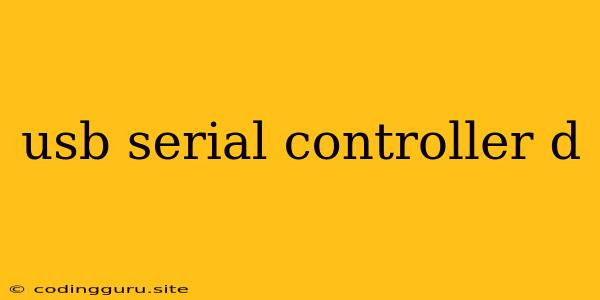Understanding USB Serial Controllers: A Guide for Connecting Your Devices
Connecting your computer to various devices often involves the use of serial ports. While traditional serial ports are gradually being phased out, USB serial controllers provide a modern and convenient way to bridge the gap between your computer and devices that rely on serial communication.
But what exactly are USB serial controllers? How do they work? And how can you make the most of them? Let's dive into these questions to gain a deeper understanding of these essential components.
What is a USB Serial Controller?
In simple terms, a USB serial controller is a device that allows you to connect serial devices, like modems, printers, or industrial sensors, to your computer using the familiar USB port. It acts as a bridge, converting the serial data signals from the device to the USB protocol that your computer understands, and vice versa.
How do USB Serial Controllers Work?
The core of a USB serial controller lies in its integrated circuitry. This circuitry contains two primary components:
-
USB Interface: This part handles communication with the USB bus on your computer, receiving and transmitting data according to the USB protocol.
-
Serial Port Interface: This part manages the communication with the connected serial device, converting the data to and from the standard serial communication protocol (often RS-232).
When you connect a serial device to a USB serial controller, the controller receives serial data from the device and translates it into a USB packet. This packet is then sent to your computer, where the operating system can interpret and use the data. Similarly, when your computer needs to send data to the serial device, the USB controller converts the data from USB format to serial format and transmits it to the device.
Benefits of USB Serial Controllers
USB serial controllers offer several advantages compared to traditional serial ports:
- Universality: USB ports are the standard connection on most modern computers, making USB serial controllers highly compatible with various devices.
- Convenience: Unlike traditional serial ports, which require specific cables and connections, USB serial controllers often come with a simple plug-and-play setup, making them easy to use.
- Increased Speed: USB technology provides higher data transfer rates than traditional serial ports, enabling faster communication with your serial devices.
- Flexibility: USB serial controllers can be readily found in various forms, including internal cards, external adapters, and even as integrated components within other devices.
Types of USB Serial Controllers
USB serial controllers come in various forms, each with its own characteristics and uses:
- Internal Cards: These cards plug directly into your computer's PCI or PCIe slot, providing a dedicated serial port interface. They offer high performance and are ideal for users requiring multiple serial ports.
- External Adapters: These adapters connect to your computer's USB port and have a serial port connector (usually DB9 or DB25) on the other end. They are portable and convenient for connecting a single serial device.
- Integrated Components: Some devices, like USB-to-Ethernet adapters, may incorporate USB serial controllers as part of their functionality, eliminating the need for a separate adapter.
Selecting the Right USB Serial Controller
Choosing the appropriate USB serial controller depends on your specific needs:
- Number of Serial Ports: Determine how many serial ports you require for your applications. Internal cards provide multiple ports, while external adapters usually offer a single port.
- Data Transfer Rate: Consider the speed requirements of your serial device. Check the controller's specifications to ensure it meets your needs.
- Compatibility: Ensure the controller is compatible with your computer's operating system and the serial devices you intend to connect.
- Form Factor: Choose a controller that suits your preferences and setup, whether it's an internal card, an external adapter, or an integrated component.
Troubleshooting USB Serial Controllers
Occasionally, you may encounter issues with USB serial controllers. Here are some common problems and their solutions:
- Driver Issues: Ensure the correct drivers are installed for your USB serial controller. If you have recently updated your operating system or installed new hardware, outdated drivers might cause conflicts.
- Port Conflicts: If you have multiple serial devices connected to your computer, there might be port conflicts. Try assigning different COM ports to your devices in the Device Manager.
- Hardware Malfunctions: In some cases, the USB serial controller itself might be faulty. Try connecting the device to a different USB port or using a different controller.
- Cable Issues: Ensure your serial cable is in good condition and properly connected to both the device and the USB serial controller.
Examples of USB Serial Controller Applications
USB serial controllers find applications in various fields:
- Industrial Automation: Connecting sensors, actuators, and other industrial equipment for monitoring and control.
- Telecommunications: Interfacing with modems, routers, and other network devices.
- Scientific Research: Controlling laboratory instruments, data acquisition systems, and other research tools.
- Robotics: Communicating with robotic controllers and actuators.
- Hobbyists: Connecting Arduino boards, GPS modules, and other electronics projects.
Conclusion
USB serial controllers play a crucial role in connecting serial devices to modern computers. They offer a versatile, convenient, and efficient solution for bridging the gap between legacy serial technology and modern USB standards. By understanding the different types of controllers, their benefits, and troubleshooting techniques, you can effectively utilize them in your applications and ensure seamless communication between your computer and your serial devices.
